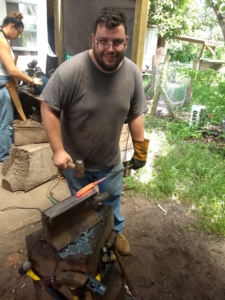By Eddie Pipkin
I had a great time recently hanging out for the weekend with my young friend, Harry. He lives in Miami, with access to a 5-acre ranchette on the edge of the Everglades where he and his dad have  constructed a homemade forge (you know, like in a blacksmith shop). He’d been sending me pictures of the knives, axes, and other metalwork he’d been creating from raw steel and inviting me to come down, so that’s how I ended up spending an entire Saturday as an apprentice blacksmith. Holy cow, it was addictive fun! I spent six hours forging a crude letter opener – banging on red-hot metal with a big hammer then grinding out a blade edge – the product of which I am told was not a bad effort for a first-timer. Although, then again, Harry is famously polite.
constructed a homemade forge (you know, like in a blacksmith shop). He’d been sending me pictures of the knives, axes, and other metalwork he’d been creating from raw steel and inviting me to come down, so that’s how I ended up spending an entire Saturday as an apprentice blacksmith. Holy cow, it was addictive fun! I spent six hours forging a crude letter opener – banging on red-hot metal with a big hammer then grinding out a blade edge – the product of which I am told was not a bad effort for a first-timer. Although, then again, Harry is famously polite.
We had a great time together, creating something uniquel our own and fellowshipping in the process (“fellowshipping” is the churchy word for meaningful hanging out together). It made me mindful of the way creative collaboration is one of the essential ingredients for vibrant ministry.
When we gather together to create new things, learning from one another and building something distinctly our own, we generate institutional energy and forge lasting bonds (pardon the intentional pun).
In the case of my blacksmithing adventure, the younger person was the teacher and the old geezer was the student. Sometimes, it’s the other way round. The point is getting people together (especially disparate people) in pursuit of a common creative goal and letting the sparks fly (did you catch that groaner of a pun as well?). Ministries have untold opportunities for creative teamwork, and this kind of collaboration and productive community is one of the defining characteristics of hearty, growing ministry.
- It’s healthy and invigorating to learn something new. It’s an injection of imagination to put people together with the express purpose of making something original (or even reinventing an old idea). Keeping different people in the mix (through rotations, bringing in new blood, inviting new perspectives, even counter-perspectives) can keep things fresh. Even if we have a great long-term team, over time that team can fall into familiar and stagnant patters (of what’s done and sometimes more importantly, how it’s done).
- We make beautiful, imaginative things together. I always like to say that the very best ideas are the ones that are so genuinely collaborative that we can’t remember whose idea it was in the first place. They are genuinely collaborative, and such co-authorship results in work that’s unexpected, rich, complex, evocative and fresh.
- We grow closer together in ways that matter when we collaborate. There is nothing like working together on challenging projects to build a strong sense of community. Difficult problems tackled successfully by talented people result in relationships with resonance. These are the kinds of bonds that prepare an institution to take on deep issues and weather tough times. To truly make a difference in our communities, we need these kinds of strong teams.
- Creative collaboration produces a profound sense of ownership in the ministry that’s happening. People care about what they own, and what they have helped build with the contribution of their own brainpower, sweat, and tears will be something they will be loyal to. They’ll be excited about it, too, eager to get others involved, eager to support it financially, and eager to graduate to what comes next.
- Creative collaboration is the THE KEY to generating and replicating our institutional DNA. When people talk about the unique identity of our ministry (which hopefully they do – because this identity is what sets us apart from the hundreds of other ministries in our zip code), what they are talking about is the personality that has organically involved because of our collaborative projects together. Many ministries thrive and then wither based on a cult of personality – that is, the vision and impact of one giant personality at the helm. Inevitably, however, ministry structured around one person fades away. Ministry that folds together the creative vision of many people working in harmony together – ministry clearly pursuing shared goals and flexible in the pursuit of those goals – lives on and evolves as needed.
You’re reading this and nodding your head in agreement. You value this kind of collaboration – at least theoretically, you value it. So, if it’s a standard on which we agree, what are the factors that keep us from practicing it? Here are some of the bumps in the road that can limit our good intentions:
- A surplus of paid staff can lead to a deficit in creative teamwork. This seems counter-intuitive, but it is a frequent real-world result. A lot of paid staff means it becomes easier to make ministry decisions and execute day-to-day ministry while only relying on staff members (or more commonly only involving staff members in decision making and idea generation – using “volunteers” for the grunt work without giving them ownership of the ministry). This approach avoids the messiness and logistical headaches of relying on ministry volunteers, but it creates a damaging disconnect in which those volunteers (who are in reality the lifeblood of any successful ministry) don’t feel invested in what’s happening. The correct biblical view of paid staff in relation to effective ministry is as team leaders (talent scouts, coaches, teachers, coordinators, encouragers, facilitators, and partners). Strong teams make for strong (lasting) ministries.
- Totalitarian leadership at the top can lead to a hyper-version of the problem outlined in the proceeding bullet point. If you are a leader who values your own opinions and strategies above all others, relentlessly insisting on your own vision at the expense of the ideas of others and micromanaging every single detail of every single endeavor, you are killing the collaboration. This stance is unhealthy (literally, creating stress for you and everyone who works with you) and creatively (killing every potential idea while it is still a seed and ensuring that your ministry will follow a dead-end path, no matter how amazing your abilities and insights).
- We are lazy (often tired) and fond of the path of least resistance. Collaboration can be fun when you’re right in the middle of it – we’ve all had that experience; it’s a rush. But setting up the collaboration – getting the people together – herding the cats – moving from ideas to useful product, can be a lot of work, so we tend to avoid it, leaning instead on the tried and familiar ideas and routines – lurching along in survival mode. We must have the discipline to remind ourselves that creative collaboration is worth the effort. We must make this a mantra of our leadership gatherings, a metric by which we measure our goals, and a pact with our leadership partners. This accountability will hold us true to leadership strategies that value meaningful team structures and strategies.
- We are unsure how to get started. Pick something about which you are confident and highly motivated. If you’re motivated, you should be excited to get other people involved so you can share your passion and develop it further. If you’re confident, you won’t be intimidated by the process of sharing new ideas, and you won’t be apprehensive about helping others learn. Once you’ve developed a collaborative process for your “passion topic,” you can apply the process to other areas that are your responsibility but for which you have less passion or skill. In this manner, you may find that your team is able to give you a sense of relief as they take on more of the work in these unfamiliar areas. Give people the freedom to thrive at what they are gifted by God to be good at! Don’t stress yourself out trying to do things at which you are not gifted!
In any ministry, people want to feel useful, involved, part of the action, and a valued part of the community. Everyone in every ministry should be collaborating on some part of that ministry. That’s how ministries thrive.
What are some of your own inspirational stories about forging ministry together? In what ways have the collaborative processes you have empowered built things more beautiful that you might have built on your own (particularly in ways that surprised and delighted you)? What challenges to collaboration have you experienced which you feel like have not been addressed in this blog? Share your own stories as part of the process of our collaboration together.







Leave A Comment